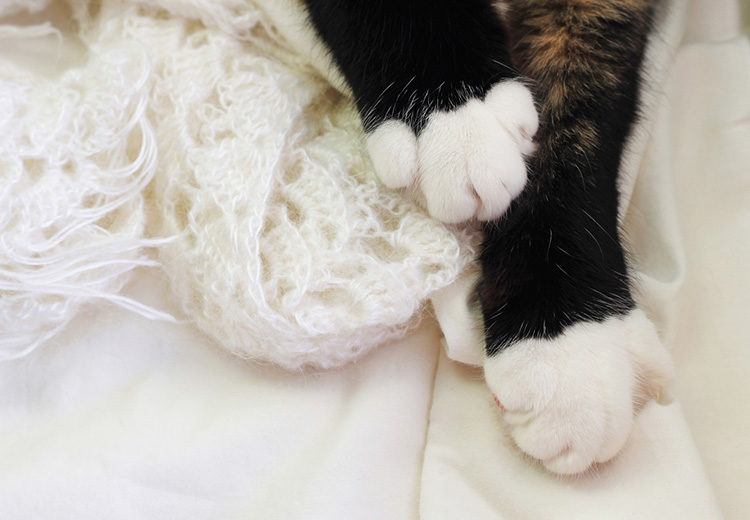I love biscuits. Look, I’m Southern; it’s a thing. I love biscuits almost as much as my tabby Tiger Jack enjoys making biscuits – not actual biscuits, of course. For one thing, it’s pretty hard to mix dough without thumbs. No, I’m talking about kneading. When it comes to kneading cat beds, blankets, my lap, my husband’s abdomen, and his favorite sleeping spots, Tiger Jack is one kneady cat.
KNEADING BASICS
How does a cat knead? A cat will push one paw against a soft surface, then the other paw, back and forth in an alternating rhythm. Some cats push hard; some cats more softly. Some cats will fully extend their claws as they stretch out their toes and press them against that soft surface, relaxing as they release and alternate paws. Other kitties only flex their toes a bit. Most felines only knead with their front paws, but some use all four legs for a hilarious display – as a kid, one of my cats looked like he meant to start a kitty ballet and dance on toe the whole way through! Many cats seem to purr in their kneadiness. (That’s another pun. Sorry, not sorry.)
WHY DO CATS KNEAD?
Here’s the thing – just like with purring, we’re not 100% sure on why cats knead. We do have several good ideas, though:
Just kitten things. When kittens are nursing at their mother’s breast, they press their little paws against her breast in that rhythmic massage fashion to stimulate the production of milk and the flow from her nipples. An adult cat giving you happy feet might be an expression they feel the same comfort and contentment they felt as brand new fuzzballs nestled close to their mom. The fact that the occasional cat will try to suckle on a blanket or your shirt while kneading is thought to support the “just kitten things” explanation for adult kneading.
Be mine. You know how cats will often rub their cheeks on you and you’re like “Awww! You love me! You really love me!” And then you see them five minutes later rubbing their cheeks on – in no specific order – the bookshelf, the kitchen door, the paper shredder, your shoes, and even the cat box? Because they have scent glands in their cheeks and everyone needs to understand just what belongs to them? (I mean, I’m sure they love you, too.) Yep, same thing might go for kneading! Cats have scent glands in their paw pads too, and kneading helps express those scent glands.
Love connection. Cats who are going into heat have been known to knead aggressively as well, which may circle back to the whole expressing the scent glands in their paw pads thing – makin’ biscuits to signal to male cats they’re ready for baby-making business.
Basic instinct. Dogs aren’t the only furry companions who circle around before bedding down – cats do it, too! Tiger Jack, in fact, kneads around in a circle while looking regal as hell, making doggos look like amateurs at the settling-in-for-a-snooze game. (Our kitten Rey circles, gets distracted by her floofy tail, chases her tail, then uses it as a pillow.) We theorize pre-domesticated cats did this long, long ago – stamping down long grass, flushing out anything hiding in it, and creating a soft nest for snuggles.
WHAT IF MY CAT DOESN’T KNEAD?
If your kitty doesn’t knead, make sure there’s no stress in their lives keeping them from relaxing. A cat who’s not comfortable or relaxed is less likely to purr around making biscuits. If your feline friend’s happy as can be and still doesn’t make biscuits? Well. Sometimes if a kitty doesn’t knead, they just don’t knead! Natural variation happens among all behaviors, even the ones that seem to be instinctual. There’s plenty of anecdotal evidence of some cats coming to kneading later in life, with no one the wiser as to why. Biscuits may still happen one day.
There you have it: everything you need to know about kneading! Now check out the best biscuit maker on the market: The BlanCat. Designed with air pockets and soft fleece to have your kitty kneading-obsessed.






